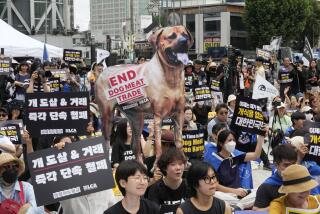Matadors See Red Over Bull Meat Ban
- Share via
SOTO DEL REAL, Spain — Luis Leiro, who raises and fights bulls, struggled to find words to explain the attraction of the centuries-old Spanish tradition.
“It’s a feeling of bravery, and that man dominates a ferocious animal in the way he wants. If you do a good bullfight, it’s art,” said Leiro, 35, who works small-town bullfights as a picador, the horseman who pokes the angry bull with a lance early in the almost ritually choreographed spectacle.
“When you go to an amusement park and take the roller coaster and it’s scary, that’s the thrill,” he said. “This is the same thing. The risk of being killed is the thrill. If you’re a spectator, you feel the same thrill as the bullfighter.”
But the European Union sees a different type of danger: the spread of “mad cow” disease--bovine spongiform encephalopathy, or BSE--through the dead bulls’ meat. In the wake of new EU rules on testing slaughtered animals, the Spanish government has banned the sale of the bulls’ meat, which normally makes up about 20% of the proceeds at small-town bullfights.
Last month, the ban nearly brought a bullfighting industry strike, which was averted only when the government agreed to pay subsidies to at least cover much of the costs of disposing the dead bulls, which typically run about $650 per animal. Six bulls are usually killed at a bullfight.
As the EU moves toward closer integration, the Spanish bull-meat ban is the latest conflict pitting rule-makers in Brussels against groups in one nation or another committed to preserving centuries-old traditions.
One of the biggest fights came in the early 1990s when European bureaucrats tried to impose a ban on cheese made from raw milk. France erupted in outrage at the threat to many of its time-honored favorites, and the rule was weakened to simply require tests to ensure that bacteria levels are below certain limits.
Some in Spain’s bullfighting industry, convinced that the safety of bull meat should be obvious to all, even see a foreign conspiracy as the only explanation for the EU rules. In recent years, some members of the European Parliament have been sharply critical of Spanish bullfighting, and British animal rights groups also have spoken out against the tradition.
“This is a political move from the European Union, probably promoted by the British, to finish off the fiesta of bullfighting . . . because they’re against hurting the animal,” said Jesus del Bosque Moyano, 33, a picador at the Soto del Real event. “Mad cow disease is the excuse.
“I understand there are a lot of people who are against bullfighting because the bull suffers. . . . But it’s a matter of respecting traditions. For example, my brother-in-law hunts. I can’t understand why he kills a deer. The deer hasn’t done anything to him. Why would he kill it? Still, I respect it.”
Although it has some support, the prohibition on selling the meat of bulls killed in the ring--which used to be sold to butchers for about $400 per bull--seems ridiculous to many fans and industry insiders.
“I love bullfights: the skill of the bullfighter, his bravery, his art, how the man controls the bull. It’s David against Goliath,” Matilda Garcia, 25, a Madrid nursing student, said in Spanish through an interpreter.
When asked about the EU bureaucrats whose rules led to the ban, Garcia switched to English: “They are more crazy than crazy cows. They are very silly and stupid.”
Such feelings are reminiscent of the earlier uproar over France’s raw cheeses. At that time, the conservative newspaper Le Figaro railed against the “standardized, aseptic and industrialized” cheese that the bureaucrats were threatening to impose.
Even Britain’s Prince Charles weighed in on that dispute, complaining about irksome hygiene rules that he said were “spreading like bacteria” throughout Europe.
Spain has confirmed slightly more than 30 cases of mad cow disease since the bovine illness surfaced here late last year, but none in any bulls.
The new EU health order requires that all cattle older than 30 months be tested for BSE when slaughtered, if the meat is to be eaten. Fighting bulls are usually about 4 years old.
“The BSE testing was put in place as a measure of consumer protection . . . and is an essential part of what we hope will be an eradication program here for BSE,” said an EU official in Brussels dealing with agricultural issues.
“The requirement from the EU is the requirement to test. It isn’t a ban on selling the meat from bulls,” she added. “This is part of our fight against BSE, and bullfighting did not even come into the picture. In fact, I don’t even know if people were aware that it would have this effect.”
The Spanish government decided to issue an outright ban, rather than try to carry out the tests, based on a variety of concerns. One worry was a shortage of veterinarians and lab technicians, especially during the August vacation season, when bullfights are most common. Another was the manner in which bulls are killed--using swords--which might contaminate the meat with potentially infectious brain and spinal cord matter.
The human equivalent of the mad cow syndrome is a fatal, brain-wasting illness known as new variant Creutzfeldt-Jakob disease. It is acquired by eating infected meat.
About 10% of the estimated 1,000 bullfights normally held in Spain during August have been canceled because of the meat-sale prohibition, Leiro and others in the industry said.
Yet ranchers argue that animals raised for bullfighting should be especially safe because they normally range rather freely, eating grass, hay and sometimes vegetable proteins, but never the kind of now-banned feed such as bone meal that helped spread the disease.
“There’s no health justification at all for this,” Leiro said. “These bulls are very healthy bulls. They only eat natural products. They drink very clean and pure water from rivers, and they run around all the time. We spoil the bulls.”
Leiro even develops something of an emotional attachment to the bulls he raises. “It hurts me to see the bull being hurt, so I don’t fight my own bulls,” he said. “I use somebody else’s.”
Not everyone in the bullfighting industry finds the ban on meat sales inappropriate.
“In my opinion, it’s a good idea to ban the meat,” said Roberto Martin, a matador who was one of the stars in a recent bullfight here in Soto del Real, a small town near Madrid.
Sebastian Sanchez, a butcher in the nearby town of Manzanares el Real, shared that view. “If there is the slightest suspicion of the possibility of an illness, health is the most important thing,” Sanchez said. “There may be some losses for the businessmen, but because the government is compensating the losses, they won’t be so big.”
Sanchez, who described himself as only moderately interested in bullfights, said he doesn’t understand why some people consider bull meat a treat. “It is usually cooked in a stew,” he said. “If you grill it, it gets too tough. In my opinion, it shouldn’t be more expensive. Veal is much better.”
But Goyi Leiro, the bull breeder’s sister, said there’s no question that bull meat is tastier because of the relatively natural and free conditions in which the animals are raised. “It’s a richer, stronger flavor, and it’s juicier,” she said.
Carmelo Perez Arevalo, 24, another picador at the Soto del Real bullfight, trained as a matador for five years. He killed 20 small bulls before switching to the horseman’s role, which provides steadier work for those not at the top of the profession.
He said he once dreamed of becoming the top matador in Spain.
When he killed a bull, “it was a feeling of complete happiness, and I felt very big,” he said. “Being a bullfighter in Spain is a big thing. When you make it to the very top, you’ve got everything--anything you want--because you make a lot of money.”
What audiences want to see “is a real man who’s brave enough to fight a bull,” he added. “It’s not just the risk. It’s the whole job he does. They want heroes.”
More to Read
Sign up for Essential California
The most important California stories and recommendations in your inbox every morning.
You may occasionally receive promotional content from the Los Angeles Times.













